skip to main |
skip to sidebar
A late arrival in Baku, Azerbaijan's capital, the previous day (described here) meant that our programme became compressed. We had managed to carry out the planned walking tour of Baku the previous evening (described here) but the day described below, the last day of my trip with Golden Eagle, was equally stimulating.
Friday 28th September 2018
Buffet breakfast was available from 06.30 a.m. in the Four Seasons large Zafferano Restaurant. At nine o'clock we all met up in Reception to join our various coaches. We were to visit the Gobustan National Park to see the ancient rock art. Our coaches slowly extricated their way south out of the city and I realised that we were retracing our arrival route the previous afternoon when the double-track electrified main line appeared on our right. Our highway, the E119 remained on the seaward side of the railway. We passed the massive LafargeHolcim Cement Plant to our right and various industrial sites to our left.
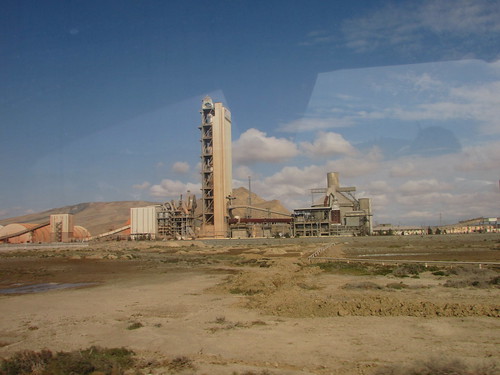
Around Baku: LafargeHolcim Cement Plant Garadagh, viewed from E119 highway.
Periodically, we passed modern police stations. Our guide invited us to recall that the transition from Soviet state to independent nation in the last twenty five years has not been without difficulties and Azerbaijan experienced a repressive and lawless phase. He suggested that the large glazed areas in modern police stations were intended to send the message that the modern police have nothing to hide.
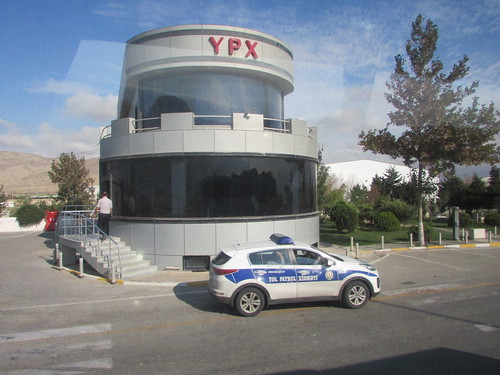
Around Baku: Local Police Station on the E119 Highway.
To reach the Gobustan National Park, now a World Heritage Site, our coach crossed over the railway line on a road bridge and climbed into the muddy-looking foothills I'd first seen the previous afternoon as we arrived at Baku by train. We parked in a car park already busy with cars and coaches. We deferred an exploration of the very modern Visitor Centre until later and our guide led us directly into the rocky area where it seemed that almost every near-vertical cliff has been embellished with primitive carvings depicting scenes from the lives of the prehistoric people who once lived there.
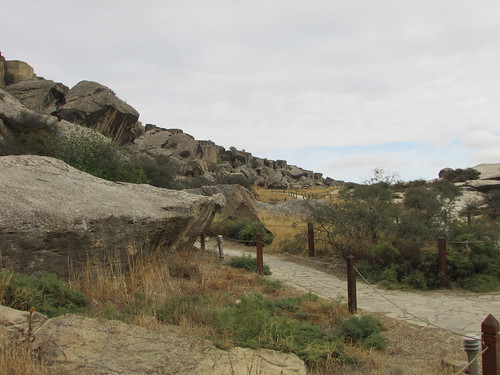
The Rock Carvings of Gobustan National Park, Azerbaijan: One of the footpaths leading through the rocky landscape.
Despite the simplicity of the artworks, I found them evocative and full of vigour. Most are believed to be between 5,000 and 20,000 years old.
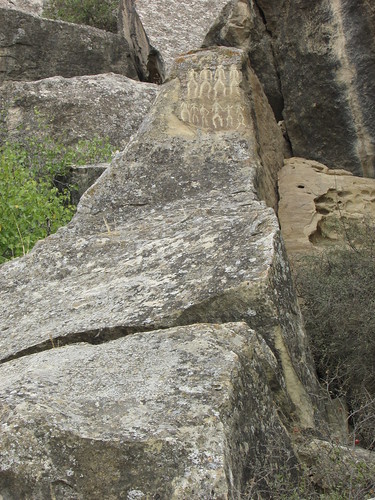
The Rock Carvings of Gobustan National Park, Azerbaijan
I found the carvings of animals particularly interesting but I'm afraid my camera couldn't really do justice to what we we saw.
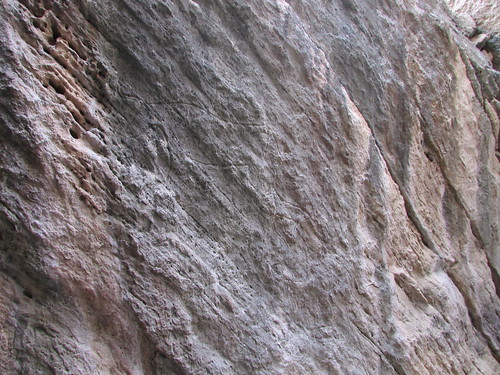
The Rock Carvings of Gobustan National Park: animal images.
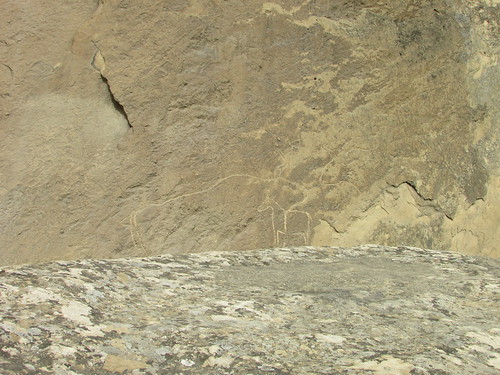
The Rock Carvings of Gobustan National Park: more animal images.
We also saw a 'Gaval Dash' - a naturally-occurring stone which resonates when struck. The example was about three feet long and this type of stone has only been found in the area of Gobustan where I assume the unique geology has produced gaseous inclusions in the stone, giving a strange ringing sound when struck by a smaller stone.

The Rock Carvings of Gobustan National Park, 'Gaval Dash' musical stone viewed from above.
I enjoyed the park itself but the modern visitor centre was rather crowded so we shuffled past the interpretations of prehistoric life fairly quickly. Nearby, there was a representation of a prehistoric village, with a number of full-size mannequin and a series of straw-covered huts. I was amused to discover that one of these huts housed a modern tea vending machine.
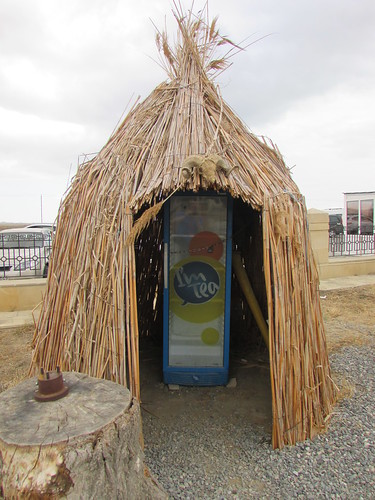
The Rock Carvings of Gobustan National Park: An unexpected tea vending machine!
The elevated site offered good views of the Caspian Sea, and the profusion of offshore oil and gas platforms served as a reminder of Azerbaijan's modern history.
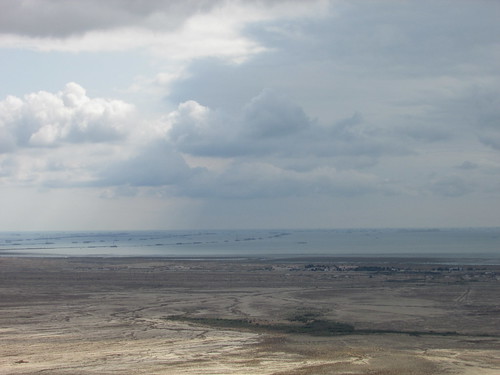
The Caspian Sea viewed from Gobustan National Park, Azerbaijan
Wikipedia has an article about Gobustan National Park here. There's also a rather frantic presentation about the site here which gives some idea of the area. I was rather disappointed that we didn't get to visit one of the mud volcanoes in the area but I suppose it tends to be a rather messy business. The mud is reputed to have medicinal qualities.
We clambered back aboard the buses and drove back to the E119 highway which lead us back towards Baku. In places, we were close to the shore of the Caspian Sea - a rather odd sight with a chain of offshore oil or gas platforms spread across the view, some complete with drilling rigs.
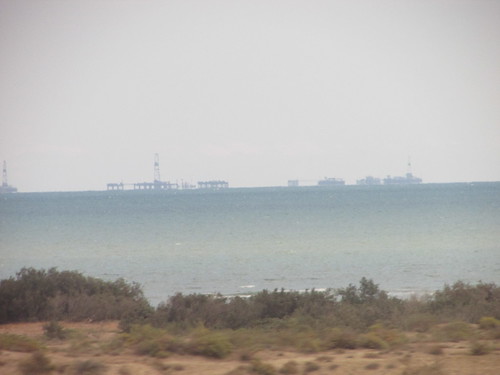
Around Baku, Azerbaijan: The Caspian Sea, with a chain of offshore oil or gas platforms.
We passed the entrance to the ambitious Khazar Islands project - a planned city to be built on around 40 artificial islands which lost funding following a fall in oil price and currently on hold. The artist's impressions on the Design Build Network site here are certainly striking.
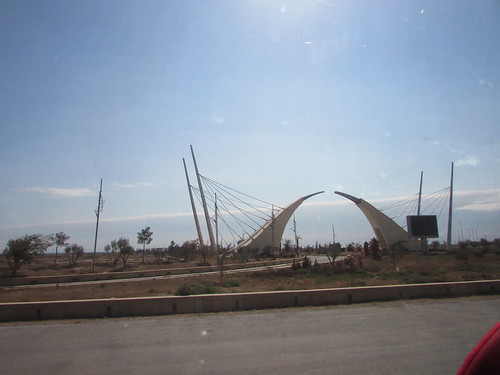
By coach to Baku from Gobustan, Azerbaijan: Entrance to Khazar Island (project currently suspended).
As we approached the city, our guide pointed out a large, informal taxi rank adjacent to a roundabout where passengers negotiate with the waiting drivers.

Around Baku, Azerbaijan: Informal 'taxi rank'.
Passing an area called Shikh Beach, we passed the waiting jack-up offshore rigs moored at a long jetty I'd spotted from the train on our arrival the previous day.

Around Baku, Azerbaijan: Moored 'Jack-up' Drilling Rigs at Shikh Beach.
We turned right off the highway into the narrow streets of Bibiheybat, an old part of the city and our coaches gingerly descended the hill towards the shore of the Caspian Sea.

Bibiheybat, Baku, Azerbaijan
We stopped near Nar Sharab hotel and restaurant where we were shown into a large restaurant overlooking the Caspian. The sun shimmering on the water and the outdoor sun terrace looked very attractive and some of the guests commented that they would have liked the opportunity to get closer to the sea but the service in the air-conditioned restaurant was friendly and prompt, the Azeri set menu was good and they served some interesting local wines.

Lunch at Nar Sharab hotel and restaurant, Baku, Azerbaijan
As we finished lunch, we were invited to choose from a revised afternoon programme of free time in Baku, a visit to the Carpet Museum or a trip to the Ateshgah Zoroastrian Temple of Fire. I chose to improve my very limited knowledge of the Zoroastrians and was shepherded onto the appropriate coach.
Bibiheybat is on a promontory thrusting into the Caspian. Our restaurant had given us views to the south but, within a few minutes of setting off, we were heading west along the northern shore of the promontory in an area called South Bay which was an active, but rather neglected, area of docks. There were four fishing vessels and four larger vessels of about 5,000 tons DWT (either oil tankers or bulkers) laid-up but looking rather sorry. I counted four floating dry docks, of various sizes, apparently in regular use.
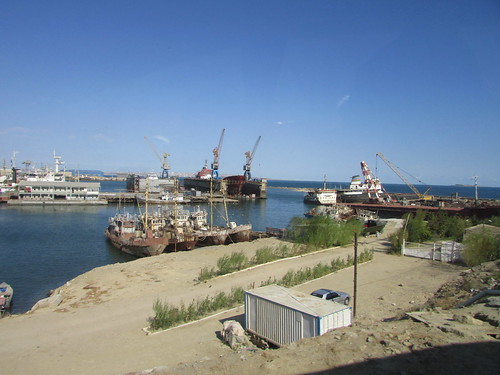
South Bay, Baku, Azerbaijan

Cargo ships laid-up in South Bay, Baku, Azerbaijan

Ocean-going tug undergoing repairs in the Floating Dry Dock 'Yusif Ibrahimov', South Bay, Baku, Azerbaijan
We passed the modern campus building of Baku Higher Oil School and then, as often occurs around Baku, we passed into a rather barren area populated only by a few 'nodding donkey' electrically-driven oil pumps, quietly extracting the source of Azerbaijan's wealth. These pump installations are more correctly called 'Pumpjacks' - there's a useful Wikipedia article here.

Pumpjacks around Baku, Azerbaijan
Equally suddenly, we were back in a modernised area with manicured lawns and the imposing Baki idman Sarayi Aquatic Palace.

Baki idman Sarayi Aquatic Palace, Baku, Azerbaijan
In keeping with any modern, capital city, Baku has equipped itself with a Contemporary Arts Centre. This is housed in one of a group of restored industrial buildings. The Yarat Centre has a website (in English) with more information here. The adjacent buildings appear to offer a variety of dining experiences.

The Yarat Contemporary Arts Centre housed in a restored former industrial building, Baku, Azerbaijan>
A little further on, a disused electricity generating station built in 1921 has been restored and re-purposed as the Heydar Aliyev Foundation's Stone Chronicle Museum (following the collapse of the Soviet Union in 1991 Heydar Aliyev was the third President of Independent Azerbaijan, succeeded on his death in 2003 by his son Ilham Aliyev who is the current President). As our coach sped by on the E119 highway, I little realised that behind the Stone Chronicle Museum, a Russian 'L' class 2-10-0 steam locomotive had been plinthed and cosmetically restored.
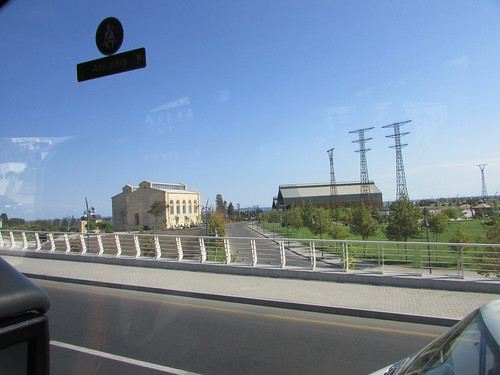
Former electricity generating station restored as the Stone Chronicle Museum, Baku, Azerbaijan. Note the disused electricity transmission towers.
We were now passing the waterfront Boulevard area with the 60 metre Ferris wheel called the Baku Eye and the not-quite-finished Caspian Waterfront Mall (there's an interesting article on the history of the Caspian Waterfront on the architect's website here).
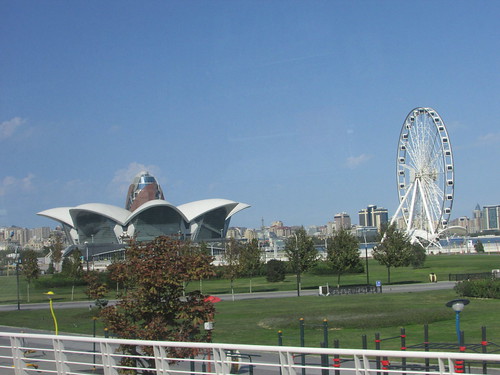
L: Almost complete Caspian Waterfront, R: Baku Eye. Baku, Azerbaijan
We passed the Azerbaijan Carpet Museum, designed to resemble a huge rolled-up carpet, then 'Mini-Venice' and the Yacht Club on our right, leaving our hotel, the Four Seasons, on our left. The coach traversed Neftchilar Avenue before turning away from the shore to continue north-east on Heydar Aliyev Avenue, passing a variety of modern buildings, some still under construction.

Around Baku, Azerbaijan
The coach continued east along the broad Airport Road before turning off into another of the strange, desolate areas around Baku of bare earth with oil derricks, pumpjacks and small capacity pipelines.
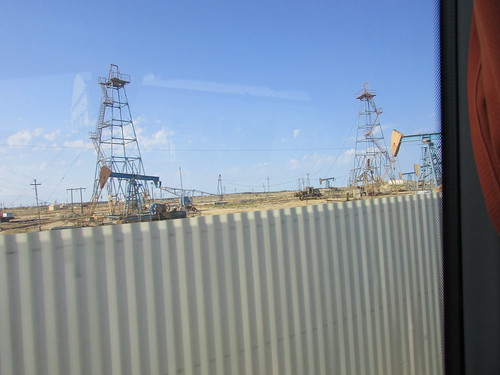
More Pumpjacks around Baku, Azerbaijan
Then we were back in a normal, suburban area, crossing a single track railway at a level crossing on the Zigh Highway before turning south-east along Balandin which took us past Surakhani station and into the coach park of the Ateshgah Zoroastrian Temple of Fire.
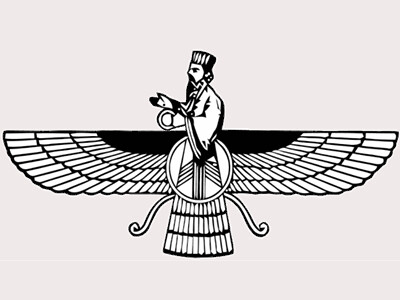
Zoroaster
Zoroaster was a Persian philosopher, prophet and spiritual leader who believed in two spiritual forces of Good and Evil with human free-will able to choose which to follow. Optimistically, he believed in the ultimate triumph of Good. He is generally thought to have lived between 1,000 and 1,500 years before the birth of Christ but this is uncertain. His thinking gave rise to the religion of Zoroastrianism which became the dominant religion in Persia.
See Zoroaster (Wikipedia) and Zoroastrianism (Wikipedia) for more.
The five-sided temple at Ateshgah has the appearance of a stone fortress, with a series of rooms and cells built into the thickness of the walls and a single access gateway, as shown in the plan below.
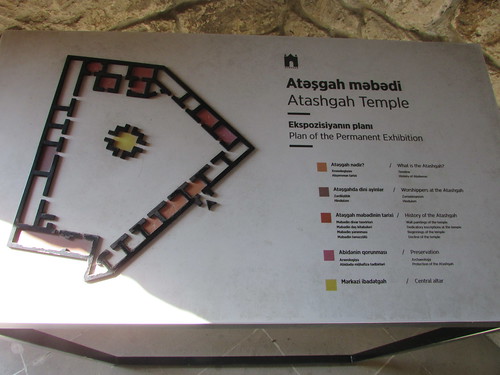
Plan of Ateshgah Zoroastrian Temple, Baku
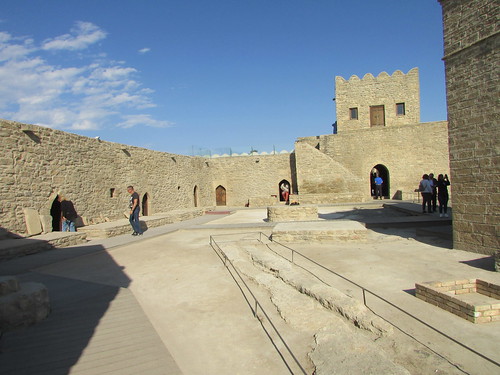
Ateshgah Zoroastrian Temple, Baku: View of inner courtyard with five doors to cells in outer wall and access gateway on right
Fire was an important symbol in Zoroastrianism and the main altar always had an 'eternal flame'. Until recently, the 'eternal flame' on the main altar at Baku was fed by a natural escape of gas but increased gas extraction rates commercially in the area resulted in connection to the gas main!
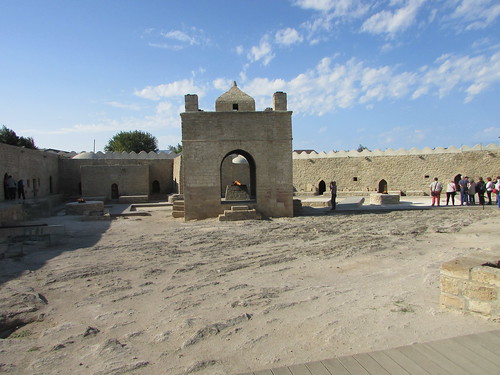
Ateshgah Zoroastrian Temple, Baku: Central altar and 'eternal flame'
Although believed to have been built during the 17th and 18th centuries for Zoroastrians, the site also became a place of worship for Hindus. The Temple of Fire is now arranged as a museum with interesting displays illustrating the life of ascetic pilgrims.
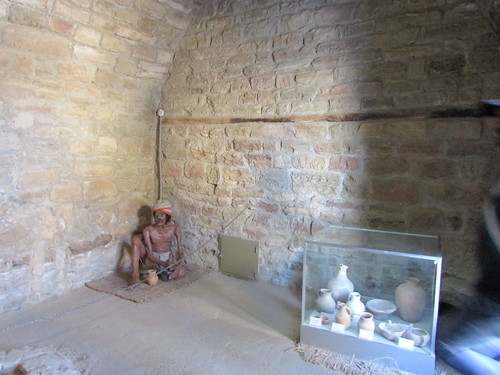
Ateshgah Zoroastrian Temple, Baku: Pilgrims' cell.
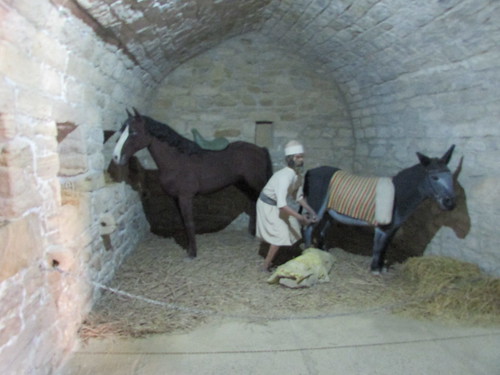
Ateshgah Zoroastrian Temple, Baku: Stable for pilgrims' horses.
See also Fire Temple of Baku (atlas obscura).
After this very worthwhile visit, it was 'back on the bus' and retrace our route to the Four Seasons Hotel in Baku, pausing briefly to admire the flowing architecture of the Zahar Hadid designed Heydar Aliyev Centre. There's more on this building on Wikipedia here.
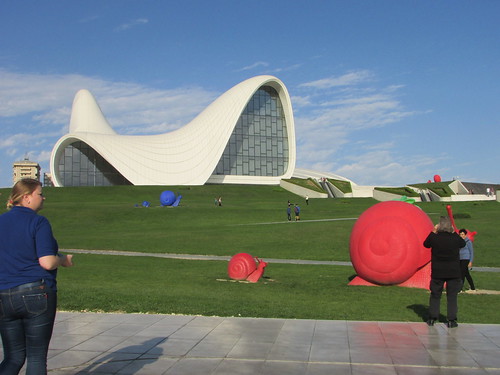
Heydar Aliyev Centre, Baku, Azerbaijan.
My 'Golden Eagle' trip was almost over - just dinner then bed because I had a very early start the following day. Dinner had been arranged for the whole party in the Mughab Club Restaurant, a few hundred yards walk from the hotel. We ate at two long tables, caravanserai-style with traditional musical entertainment provided. The meal was enjoyable but those of us with early departures the following day were happy enough to make our way over the cobblestones of the lanes leading us back to the main road, the hotel and bed after a packed day of excursions in Baku.
Related posts on this website
This is the last one of a series of posts describing my 'Golden Eagle' Caspian Odyssey trip, starting with Travelling East.
Alternately, clicking on the 'All my Caspian Odyssey reports' link displays all the posts on this trip in reverse date-of-posting order.
All my Caspian Odyssey reports.
On leaving Baku by air, I flew to Istanbul for a weekend. Clicking on the 'Next report' link below displays my first post describing Istanbul.
Next report.
My pictures
These albums include more pictures of the events described above:-
Four Seasons Hotel, Baku, Azerbaijan.
Around Baku, Azerbaijan.
The Rock Carvings of Gobustan National Park, Azerbaijan.
Ateshgah Zoroastrian Temple, Baku.
All my pictures taken in Azerbaijan (except 'technical' railway pictures) are in the collection Azerbaijan.
Although the double-track Liverpool & Manchester Railway initially adopted a 'Time Interval' system between trains which were only allowed to travel in one direction on each line, over time the deficiencies of this system had to be addressed, because of the risk of a following train running into the rear of an unexpectedly-halted previous train.
Train Staff Working
But single-line railways needed a different approach from the start as there was not only the danger of one train catching up with another but the possibility of trains travelling in opposite directions meeting head-on. The Americans have an evocative phrase for this event - 'cornfield meet'. In the U.K. the system of a 'Train Staff' was adopted. This was often a rounded length of wood (hence the name 'staff'). There was only one Train Staff for each single line section, marked with the section of line to which it applied. Before entering a single line, the driver took possession of the unique Train Staff and was thus assured that no other train was occupying the section. On clearing the single line, the driver would surrender the staff, allowing another train to enter the single line. Provided drivers were in possession of the the Train Staff when on the Single Line, this simple system was safe.
To increase the capacity of the line, a long single line was often divided into separate sections by intermediate stations provided with passing loops. There was only one Train Staff for each single line section between passing loops, marked with the names of the two stations between which it applied. Again, provided the footplate crew made certain they were carrying the correct staff for the section, the system remained safe. Train Staffs could be distinctively painted or shaped to assist the driver and fireman in identifying the correct staff but enginemen were also expected to read the names of the stations marked on the staff as a cross check. When I was a trainee fireman in preservation, I was taught to collect the Train Staff from the Signalman (or person in charge), check the details, shout "Correct Staff!" then display it to my Driver so that he could independently satisfy himself that we had proper authority to enter the single line section.
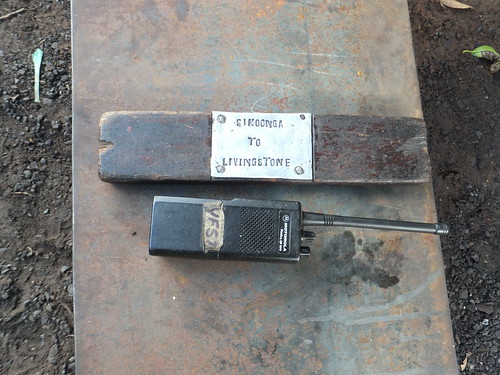
Simoonga - Livingstone single line staff (and two-way train crew radio), Victoria Falls Steam Railway, Zambia.
A bigger problem with this simple system was its inflexibility. If trains alternated in direction on the single line, the first train carried the staff from station A to station B, the second train, in the opposite direction, returned it from station B to station A. But there was no way for a second train from A to B to follow the first whilst the Staff remained at station B. There are tales of junior porters having to carry the Staff to the opposite end of the single line by bicycle in exceptional circumstances.
Train Staff and Ticket Working
Train Staff and Ticket Working seeks to address the inflexibility of ordinary Train Staff Working. The signalman or Person in Charge at station A must be in possession of the Train Staff before allowing a train into the single line section.
If a second train will run in the opposite direction, the Train Staff is actually CARRIED by the driver of the first train so as to be available for the second train on arrival at station B.
If a second train will follow the first in the same direction, the driver of the first train must be SHOWN the Staff. Seeing the Staff gives assurance that another train has not entered the opposite end of the section. The signalman also issues a numbered paper Ticket to the driver, identifying the specific train and giving authority to pass through the single line. When the train arrives at station B, the ticket is surrendered to the Signalman or Person in Charge there who cancels the Ticket. Because the Train Staff is still at station A, a second train may follow, this time with the driver CARRYING the Staff (unless a further Ticket is issued because of a third train in the same direction).
With Staff and Ticket working, telephone communication between the Signalmen or Persons in Charge at either end of the single line is essential because a further Ticket must not be issued until any previous Ticket had been correctly received and cancelled. Before allowing a train onto the single line, the Signalmen or Persons in Charge at both ends must agree upon the direction of the NEXT train required to pass over the single line. Whether a driver receives the Staff or is shown the Staff and receives a Ticket depends upon the direction of the NEXT train through the section. If the next working is in the opposite direction, the Staff is carried to the other end so it can be given or shown to that train. If the next working is in the same direction, the driver is shown the Staff (so that it can be shown to or carried by the following train) and CARRIES the Ticket. Tickets are valid for one specific train and, after a single use, are cancelled by the Signalman or Person in Charge receiving the used ticket.
Electric Token Working
Single-line control eventually benefited from the use of electrical interlocking from one end of a single line section to the other, allowing multiple single line tokens to be housed in machines at either end of each single line but ensuring that only one token could be released at a time and that it had to be returned (to either machine) before a further token could be extracted (from either machine). This arrangement allows 'unbalanced' working of trains until either machine runs out of stored tokens. Numerous designs are in use in various parts of the world, including:-
Electric Key Token ('Lollipop' token).
Tablet (round, metal disk token).
Ball token (Neale's pattern as widely used in Thailand)
This very simple explanation clearly needs expanding in the future.
Interlinking with Signals
A feature of British signalling practice where a train staff is used is an electrical interlock to ensure that the appropriate staff is present in the signal box before the signal admitting a train to the single line (the 'section signal') can be 'cleared'. For instance, this safeguard is provided at Shackerstone on the Battlefield Line.
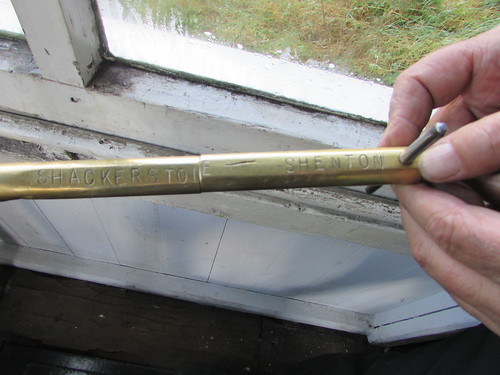
The Single Line Token at Shackerstone.

The Single Line Token, showing the incorporated 'Castell Key'.
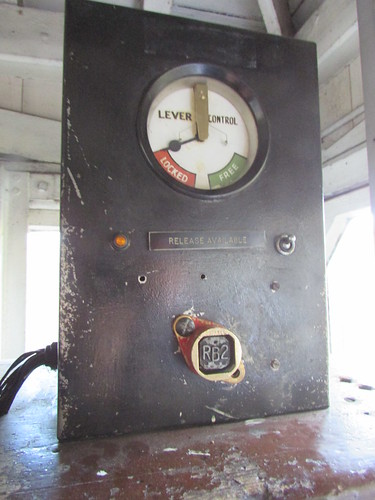
The Release equipment in Shackerstone signal box for the 'Section Signal'.

Token inserted into Release equipment.

Token inserted into Release Control and turned. Yellow Lamp lit indicates the release is available to allow the 'section signal' to be 'cleared'.
Pilotman Working
If a train staff is lost or damaged or electric token equipment fails, subject to suitable safeguards, trains may continue to run using a 'human agent' as a Pilotman. He identifies himself to all staff by wearing a special armband marked 'PILOTMAN' (or, in exceptional circumstances, an armband made from a red flag).
Related articles on other sites
Token (railway signalling) Wikipedia.
Indian Railways single line instruments The Signal Box.
My previous post here describes our journey across Azerbaijan, arriving in Baku station at 16:34. It was already becoming dusk and I was quite ready to retire to a hotel room but the organisers had decided that our walking tour of the Old City, which had been planned for that morning, would take place before we checked into our hotel.
A little background
The history of the area now forming Azerbaijan is very complex. There's a useful Wikipedia article here but I found a three-minute animation from 'Cartographious' here which shows the various changes informative. Use the 'Back Button' to return here. Imperial Russia, seeing the strategic importance of the area, pursued a series of wars against Persia and eventually managed to wrest control, as shown in another animation, this time from 'EmperorTigerstar', here. Use the 'Back Button' to return here.
The astonishing wealth-creation and growth of Baku in the 19th century resulted from the unique geology of the area. The world's first oil well was drilled at Bibiheybat, Baku in 1846 and the increasing demands for petroleum products both in the Russian Empire and in the West had attracted the attentions of the Nobel Brothers and Rothschilds by 1883.
Thursday 27th September 2018 (Evening)
The coaches drove us on busy streets from Baku railway station to a dropping-off point near the Old City. Although there were large, ambitious modern 'skyscrapers', the more conservative architecture lining the streets was similar to European and American cities developed in the 19th and early 20th centuries featuring Baroque, Gothic and Beaux-Arts styles, together with later Soviet styles. The picture below illustrates this architectural mix, with a medieval Persion palace (foreground), Soviet-style (rear left - although Baku TV Tower, started 1979, was not completed until 1996 after the collapse of the Soviet Union) and ultra-modern (rear right two of the three 'Flame Towers' described on Wikipedia here).

A mix of architectural styles in Baku, Azerbaijan: Persian, Soviet and ultra-modern.
The Baku Executive Authority Building, completed in 1904, was built as a Municipal Duma or town hall in the Baroque building style and now serves the Mayoralty of Baku. There's a Wikipedia article here.
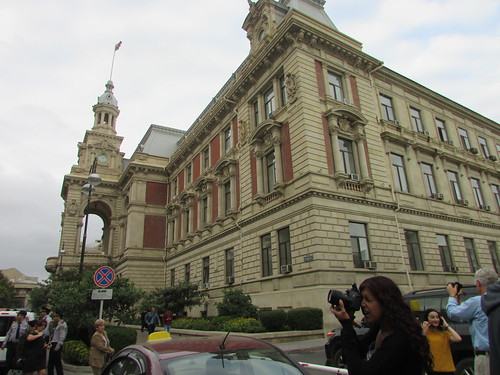
Baku Executive Authority Building
We came across various oddities, like a strange larger than life size bust of the Baku poet Aliaga Vahid (1894-1965) and the Baku Museum of Miniature Books (see Wikipedia article here).
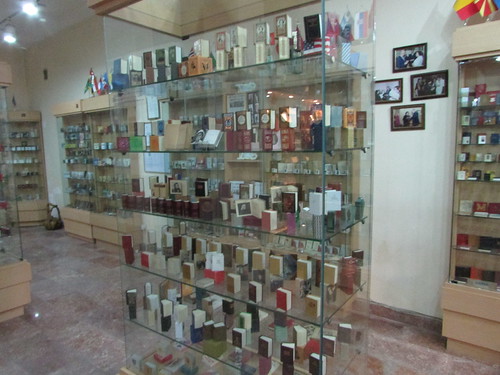
Baku Museum of Miniature Books, Baku, Azerbaijan
The Old City, Icherisheher, was built when Azerbaijan formed part of the Persian Empire, incorporating 12th century (or perhaps earlier) features and defensive walls, with later additions. There's a Wikipedia article here. Our walk took us past the surviving parts of the encircling Old City walls and the Maiden Tower. The Old City has been changed by modern reconstruction but a model on display in the Palace of the Shirvanshahs gave an impression of the 15th century city. The Old City, including the Palace of the Shirvanshahs, is now a World Heritage Site
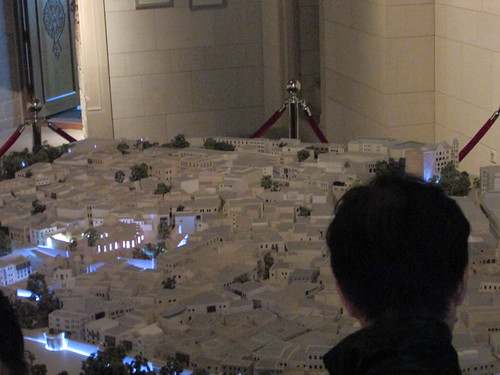
Model of 15th century Baku, Azerbaijan
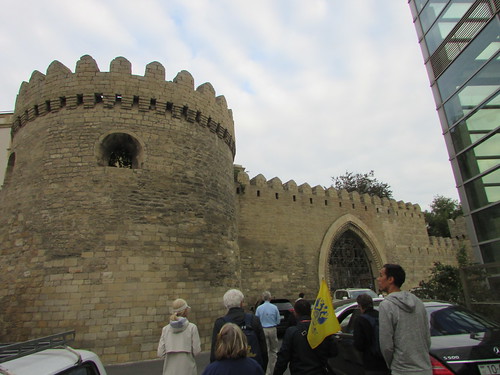
Walls of the Old City, Baku, Azerbaijan
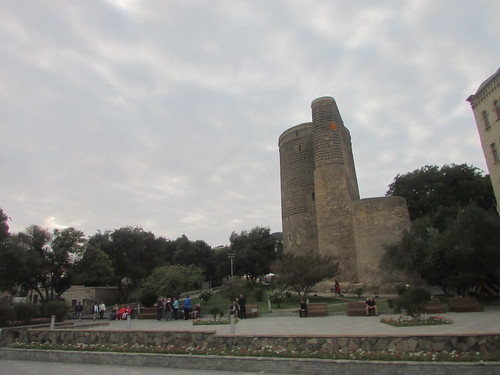
Maiden Tower, Old City, Baku, Azerbaijan
The highlight of our walking tour, for me, was a visit to the 15th century Palace of the Shirvanshahs. Considerable reconstruction has been carried out and, although its detailed history is still a matter of some debate, I found it a fascinating and tranquil complex of elegant buildings.
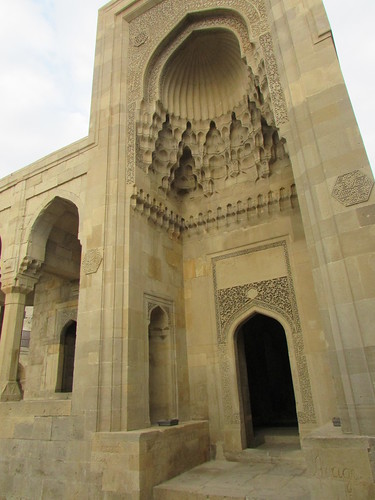
Palace of the Shirvanshahs, Baku, Azerbaijan

Palace of the Shirvanshahs, Baku, Azerbaijan
Below I list Wikipedia and other articles which give more background on the Palace of the Shirvanshahs:-
Palace of the Shirvanshahs (Wikipedia)
PALACE OF THE SHIRVANSHAHS (Alluring World)
Shirvanshah Palace, Baku (Advantur)
Palace of the Shirvanshahs (Azerbaijan International)
We left the Palace and continued our walking tour, past preserved bathhouses and a medieval caravanserai but, by this time, my tiredness was overcoming my concentration and I felt quite relieved when I saw that we were finally headed towards the Four Seasons Hotel.
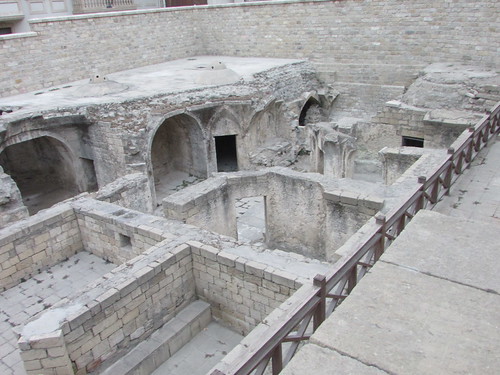
Preserved bathhouses in Baku, Azerbaijan
I was a little worried that, with a fair number of guests arriving simultaneously, check-in might take a while but, in fact, I was issued with a room key within a few minutes and gratefully headed for the lifts. My room was well-appointed and huge.

Four Seasons Hotel, Baku, Azerbaijan
Related posts on this website
This is one of a series of posts describing my 'Golden Eagle' Caspian Odyssey trip, starting with Travelling East.
Clicking on the 'Next report' link (where shown) displays the post describing the next events. In this way, you may read about the trip in sequence.
Next report.
Alternately, clicking on the 'All my Caspian Odyssey reports' link displays all the posts on this trip in reverse date-of-posting order.
All my Caspian Odyssey reports.
My pictures
These albums include more pictures of the events described above:-
Baku walking tour, Azerbaijan.
Four Seasons Hotel, Baku, Azerbaijan.
Around Baku, Azerbaijan.
All my pictures taken in Azerbaijan (except 'technical' railway pictures) are in the collection Azerbaijan.
With a reasonable weather forecast for Saturday, 17th November 2018, I decided to repeat the day trip to Liverpool which I occasionally make. Public transport in my area is now more restricted, so the possibility of bus to Penkridge to catch the train (as described in the post here) no longer exists. Instead, I presented myself at the bus stop for the first service to Wolverhampton, due at 08:35. I'd hoped that, if it ran to time, that might allow me to catch the 09:20 'London Northwestern Railway' service to Liverpool. When the bus arrived over ten minutes late, I resigned myself to a later departure from Wolverhampton but the bus made good time and, after getting off in Stafford Street a brisk walk to the station made me more optimistic about catching the 09:20.
Railway Drive has been blocked to vehicles for some time as the 'Midland Metro' at last constructs its extension from the present inconvenient St. George's terminus in Bilston Street to the railway station. A light rail system for the West Midlands was mooted in the 1960s but it was 1981 before serious studies were made and 1999 before trams on a single route from Wolverhampton to Birmingham Snow Hill started running. In my 2016 post Grand Central and Birmingham New Street Station I described progress on the extension at the Birmingham end to Birmingham New Street station and that is now in use. As I hustled to the station, I could see that track laying (using inset track) had started in Railway Drive - a mere 20 years after the opening of the light rail system.
Although the 09:20 was on time, I was able to catch it after all and I would have enjoyed the ride apart from a 'Hen Party' of a dozen ladies and one man who noisily crowded into my coach with their plastic wine glasses, a large bottle of prosecco and various mixers, celebrating a birthday (I couldn't determine whose) in a particularly noisy fashion which continued unabated until our arrival in Liverpool.
We stopped in platform 11 at Crewe, as usual, and I admired the polychrome brickwork I'd commented on in an earlier post here. There's a brief description of Crewe and the architecture of its station in the post Crewe Station.
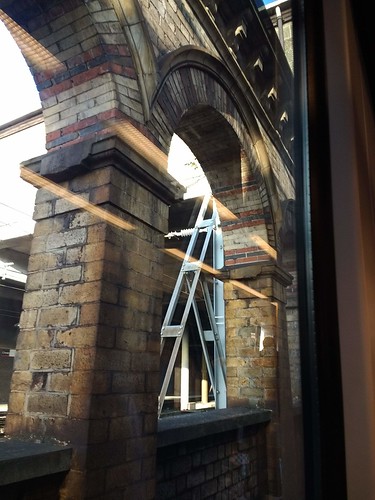
Crewe Station 17-Nov-2018: A close-up of the polychrome brick supporting wall flanking platform 11 (apologies for the reflection of the carriage lighting).
As we continued to Liverpool, we passed considerable re-signalling work in progress. I couldn't determine the present extent but some new colour light signals were in use, with the control code 'WE' and 4-digit signal numbers so I concluded that at least part of the line has now transferred control to the Manchester Rail Operating Centre. I still have trouble grasping that we'll end up with just 14 such Operating Centres in the country (Derby, Gillingham, Cardiff, Saltley, Edinburgh, Ashford, Didcot, Glasgow, Three Bridges, Manchester, Romford, York, Basingstoke, Rugby). Halton Junction signal box seemed to have gone and the Air Raid Precautions signal box structure at Runcorn had the windows papered over so presumably is no longer operating. Ditton Junction, Speke Junction and Allerton Junction appeared to be still in use but no doubt their days are numbered. We swept past Edge Hill signal box and descended through Edge Hill Cutting where new signals were in evidence. Lime Street station re-opened in July 2018 following a period of complete closure allowing the modernisation work to be completed. There's more information about the work undertaken in a 2016 article from Rail Engineer here.
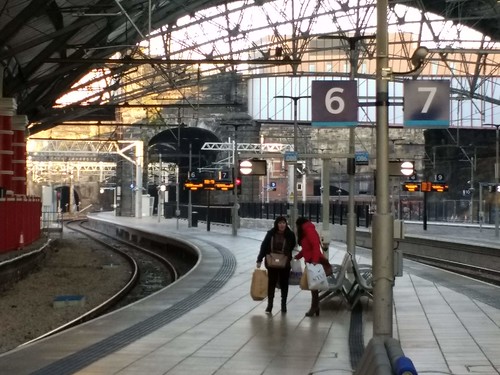
Liverpool Lime Street Station, 17-Nov-2018
I purchased a 'Saveaway' ticket allowing travel on buses, trains and ferries within Merseyside that day and descended by a series of escalators to the underground 'Mersdeyrail' platform at Lime Street Station. The first train took me two stations to James Street, where one of a series of lifts returned me to street level. It wasn't too warm but the sun was shining brightly so it was a pleasant walk to the Waterfront. I judged I'd not have time to catch the 11.00 a.m. Mersey Ferry, so I watched 'Royal Iris of the Mersey' slip way from Pierhead before entering the Museum of Liverpool where I checked that the star exhibit, the locomotive 'Lion', was still safe. I walked around the outside of the Museum to take a photograph of the Old Pilotage Building.

Liverpool, 17-Nov-2018: The Old Pilotage Building.
Next to the Old Pilotage, I found a massive display of 'Love Locks'. There's an article on this phenomenon here.
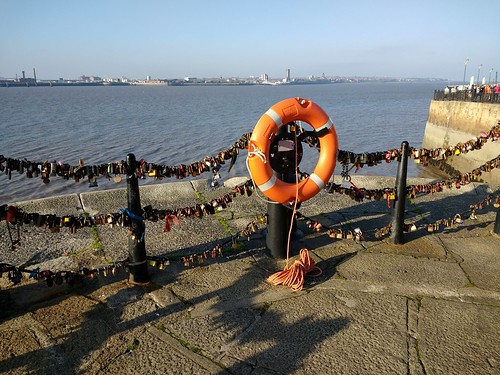
Liverpool, 17-Nov-2018: 'Love locks' overlooking the Mersey.
The clocks on the Liver Building were once again working and my picture shows the bright sun and blue sky on the day.
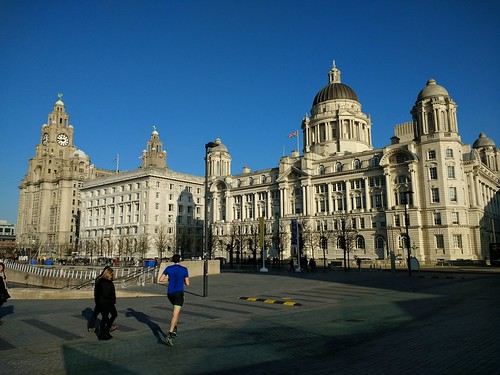
The 'Three Graces'.
It's become a tradition that I take the Mersey Ferry when in Liverpool, so I boarded the ferry which left at noon. Once we set off, the wind on the river was quite fierce, but with jacket zipped-up and gloves on, I was fine. The ferry first heads downstream on the Liverpool side whilst the pre-recorded commentary describes the north docks. We passed a number of small motor vessels moored with groups of men rod fishing. A large vessel was approaching us mid-stream and, as it came closer, I identified the passenger/car ferry 'Ben-My-Chree' returning from Douglas, Isle of Man. Once she'd passed us, our ferry turned to port to cross behind 'Ben-My-Chree' and head back upstream on the Birkenhead side. As we crossed through the wake of the larger ship, there was a fair amount of pitching. We berthed at Seacombe Landing stage with another vessel already moored.
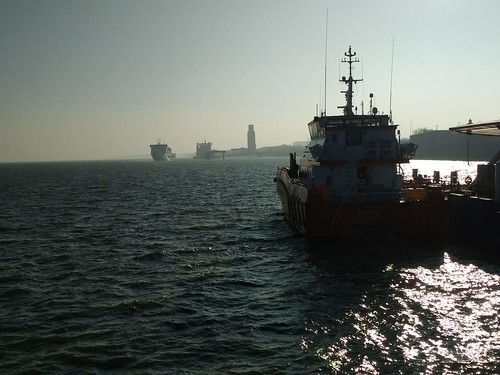
Liverpool, 17-Nov-2018: View from Mersey Ferry 'Royal Iris of the Mersey' approaching Seacombe Landing Stage with catamaran Njord Magni already moored at the south end. In the background, 'Ben-My-Chree' is berthing at Twelve Quays.
After passengers had alighted and boarded at Seacombe, we set off upstream past the moored vessel - crew transfer vessel 'Njord Magni', one of the high-speed catamarans which services the various offshore windfarms established in the Irish Sea. We passed the northern berth at Twelve Quays whilst 'Ben-My-Chree' was still docking. The southern berth was occupied by 'Stena Forerunner', which I don't believe I've seen before, apparently currently operating the Belfast service.
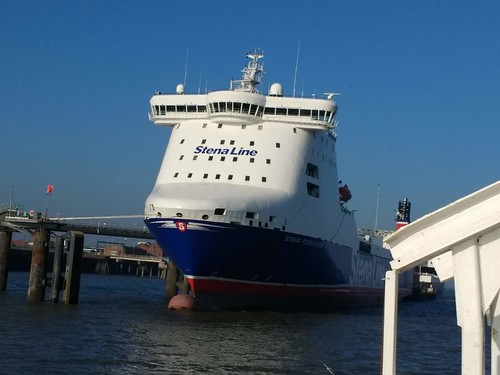
Liverpool, 17-Nov-2018: Twelve Quays, with 'Stena Forerunner'.
We docked at Birkenhead Woodside Landing Stage, where I left the ferry before it completed its triangular cruise by sailing back to Pierhead, in time to form the next departure from Liverpool Waterfront at 1.00 p.m.
I made the usual walk to Hamilton Square Merseyrail station and descended to the underground concourse serving the three platforms using one of the series of electric lifts. After a few minutes wait, I boarded the next train to New Brighton. New Brighton's Victoria Road led me to the Old Town, where I purchased a fish cake and chips which I ate as I walked to the Marine Promenade. I sat in one of the delightful Victorian shelters to finish my meal. The bright sun had encouraged lots of people to 'take the air' and there was quite a holiday atmosphere. I decided to patronise the ice cream van selling soft ice creams before continuing west. I passed Fort Perch Rock but decided to defer my visit to the weekend museum based there. Their website is here. I continued past the Marine Lake, admiring the decommissioned New Brighton Lighthouse (a Grade II* listed building) and entered King's Parade, with its modern shopping centre on my right and New Brighton Lifeboat Station, where they operate a rigid inflatable inshore lifeboat (a 'B' class 'Atlantic'). Then I turned left into Atherton Street to return to the railway station, noting that the local signage seems to have adopted the dreadful modern importation 'Train Station'. A stiff climb took me back to the attractive, welcoming and warm Merseyrail station and, somewhat exhausted, I thankfully took my seat on the waiting 3-coach train.
This time, I stayed on the train all the way to Liverpool Lime Street, noting that the journey between Hamilton Square and James Street stations had taken just over five minutes - considerably quickly than my enjoyable surface journey in the opposite direction a few hours earlier! A Birmingham service was already in platform 7 and I was happy to take this train back to Wolverhampton after a pleasant, if short, trip to Merseyside.
Related posts on this website
To view all my posts on Merseyside, click here or, alternately, select label 'Merseyside'. Posts are displayed in reverse date-of-posting order.
My pictures
This album includes pictures taken during this trip:-
Liverpool.























































